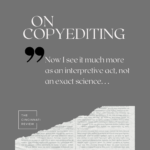 Rochelle Hurt: Hybridity is a topic of much discussion of late: hybrid cars, hybrid crops, hybrid dogs (the Goldador, the Peekapoo, the Schnoodle). It’s always exciting to encounter something that inhabits two seemingly separate worlds at once. What I love most about hybrid dogs is the way their breed labels carve out entirely new spaces for these creatures. The Goldador is not a Labrador that looks sort of like a Golden Retriever, nor is it a Golden Retriever that barks sort of like a Labrador. It’s something else entirely; it’s a Goldador.
Rochelle Hurt: Hybridity is a topic of much discussion of late: hybrid cars, hybrid crops, hybrid dogs (the Goldador, the Peekapoo, the Schnoodle). It’s always exciting to encounter something that inhabits two seemingly separate worlds at once. What I love most about hybrid dogs is the way their breed labels carve out entirely new spaces for these creatures. The Goldador is not a Labrador that looks sort of like a Golden Retriever, nor is it a Golden Retriever that barks sort of like a Labrador. It’s something else entirely; it’s a Goldador.
Amanda Lee Kallis’s “Abeyance” in issue 12.1 also inhabits (at least) two worlds at once, making use of literary conventions associated with two different genres. Viewed from one angle, “Abeyance” is a long prose poem sequence (which is how it’s categorized in our issue), but from another angle, it’s a segmented lyric essay. The best way to read it, in my opinion, is from a vantage between these two. Let’s call it an essem or a poessay—or better yet, let’s not worry about its particular genre and instead just revel in its strange beauty.
Kallis blends scientific terminology and philosophy (from Descartes, Horace, W. E. B. Du Bois, and others) with lyrical descriptions in a fragmented meditation on mind and body. In the first section, Precursor, she writes: “Negligible or non-senescence is observed in the hydra, a water creature. . . . The price of biological immortality: pearly simplicity and some nettling tentacles about the mouth.” Through a fusion of the discursive essay voice and poetic metaphor, she creates a fresh mode for discussion of the body. Her movement through the piece is largely associative, following rhythmic echoes of phrases and images. Take, for example, this passage from section 11, Scale: “So much talk before speech. You have to snake the clog. My insides are pitched. Immortality is a snaking thing. Immortality is a dog chasing its tail.”
“Abeyance” uses formal hybridity, not simply as a means of innovation, but rather as a reflection of its content. In this piece, the acts of aging, seeing, reading, writing, and understanding, are often hybrid processes. In section 8, Monsieur C, Kallis writes: “A stroke, of course. A shattering deep somewhere. A visible silence. The most significant finding for our purposes is that, in all of that circuitry, the seat of writing is not that of reading and yet we can talk, you and I, in an uneven silence.” The use of synesthesia in the phrase “visible silence” reveals the body as a natural hybrid. We process information through a series of almost imperceptibly distinct mechanisms (sight, sound, smell, touch, taste) that become one through the very act of perception. In this way, “Abeyance” is also a piece of meta-writing that provides a guided tour through our own process of reading it.










